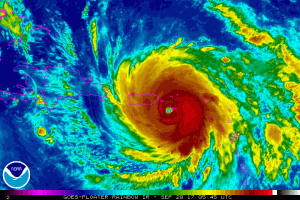Before and After the Hurricanes: NEON Data for Harvey, Irma and Maria
November 2, 2017
The hurricane season of 2017 has been one for the record books with three major hurricanes making landfall on U.S. states and territories within a four-week period. Hurricanes Harvey, Irma and Maria have left devastating impacts on Texas, Florida and Puerto Rico that the research community is just beginning to understand.
To help build that understanding, the National Science Foundation (NSF) has awarded 59 grants totaling $5.3 million to researchers studying the effects of the hurricanes on communities and ecosystems in their paths. The selected research projects span a broad range of topics, from neighborhood characteristics that build resilience to the protective effects of coastal wetlands. The results will build our understanding of how hurricanes impact people and wildlife, the ways in which damage can be mitigated, and how recovery efforts can be accelerated.
Ecological data will be key to many of the studies. What effect will the flooding in Texas have on aquatic and terrestrial ecosystems, and how long will it take for them to recover? How are microbial communities changing in the impacted areas? How have chemical contaminants been dispersed by the hurricanes, and what effects does this have on human health and the environment?
Data collected at NEON field sites in Texas, Florida and Puerto Rico could help answer some of these critical questions. NEON field sites collect a broad range of ecological data from terrestrial and aquatic environments as well as data from airborne observation platforms. Using both sensors and field data collection, the NEON network of field sites produces more than 180 different ecological data products, including measurements of vegetation coverage, microbial diversity and abundance, terrestrial and aquatic animal diversity and abundance, aquatic nutrient and chemical fluxes, and many more.
Although the full complement of data products for each site are not yet available, NEON has been collecting data at sites in Texas and Florida since 2013 and in Puerto Rico since 2015. While the sites in Texas were not in Harvey’s direct path, they are recording terrestrial and aquatic data that could be valuable in examining the broader impacts of Harvey on the environment. While sites in Florida have terrestrial data, data gaps are present among others due to the damaging effects of the hurricane. Scientists have been collecting observational sampling data at two terrestrial sites in Puerto Rico since 2015 and at two aquatic sites since 2016. Sites in Puerto Rico are currently offline in the immediate aftermath of Maria but will be back online shortly and will be valuable sources of data as scientists examine the ecological impacts over the next months and years.
Data collected from the NEON field sites are freely available to scientists and the public. Find more information about the availability of data from each of the sites here or send an email to neonscience@battelleecology.org.
Image credit: Infrared loop of Hurricane Maria passing St. Croix, Vieques, and landfalling on Puerto Rico on the morning of September 20. Courtesy of NOAA.
